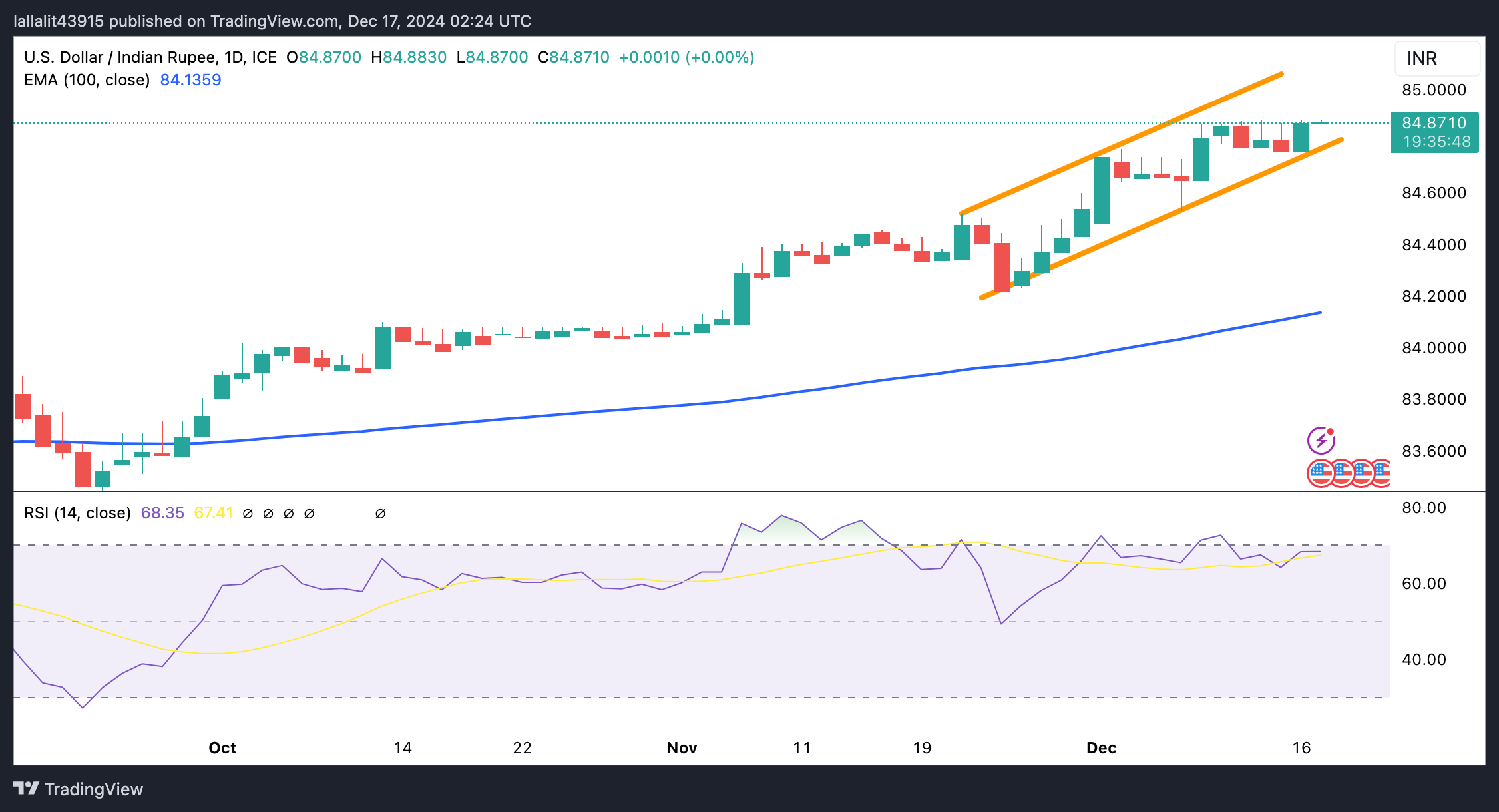- The Indian Rupee remains stable in the Asian session on Tuesday.
- Rising US bond yields and a weaker Chinese Yuan could hurt the INR, but RBI intervention could help limit its losses.
- Traders prepare for US November retail sales on Tuesday, ahead of the Fed’s rate decision.
The Indian Rupee (INR) consolidates in a tight trading range on Tuesday after weakening to a new closing low in the previous session. A rise in US Treasury yields and weakness in the Chinese Yuan put some selling pressure on the local currency. Furthermore, India’s widening merchandise trade deficit in November weighs further on the INR.
Any significant depreciation of the Indian Rupee could be limited as the Reserve Bank of India (RBI) is likely to sell USD through state-owned banks to avoid excessive volatility. November US retail sales will be released later on Tuesday. All eyes will be on the US Federal Reserve’s (Fed) interest rate decision on Wednesday for fresh catalysts. Additionally, Fed Chair Jerome Powell’s press conference and updated economic projections will be closely monitored.
Indian Rupee Steady on Global Signals
- India’s WPI inflation eased to a three-month low of 1.89% in November from 2.36% in October, the Ministry of Commerce and Industry showed on Monday. This figure was lower than expected, which was 2.2%.
- The preliminary estimate released by HSBC on Monday showed that the Indian manufacturing Purchasing Managers’ Index (PMI) rose to 57.4 in December from 56.5 previously.
- India’s services PMI rose to 60.8 in December from 58.4 previously. The composite PMI jumped to 60.7 during the same reporting period from 58.6 in November.
- “The small increase in the manufacturing PMI in December was mainly due to gains in current production, new orders and employment,” said Ines Lam, economist at HSBC.
- The US S&P Global Composite PMI improved to 56.6 in the December flash estimate from 54.9 previously. Meanwhile, the services PMI rose to 58.5 in December’s flash estimate from 56.1. The manufacturing PMI fell to 48.3 from 49.7.
USD/INR maintains long-term bullish trend
The Indian Rupee is trading flat on the day. The constructive view of the USD/INR pair prevails, with the price holding above the 100-day EMA on the daily chart. Furthermore, the 14-day Relative Strength Index (RSI) is above the midline near 68.35, supporting the short-term buyers.
The ascending trend channel and the psychological level of 85.00 seem to be a difficult hurdle for the bulls to overcome. A sustained bullish momentum could even take USD/INR to 85.50.
On the other hand, the first downside target to watch is the lower boundary of the trend channel at 84.80. A break of this level could expose 84.22, the November 25 low. The potential support level for the pair is seen at 84.13, the 100-day EMA.
Indian Rupee FAQs
The Indian Rupee (INR) is one of the currencies most sensitive to external factors. The price of crude oil (the country relies heavily on imported oil), the value of the US Dollar (most trade is done in US dollars), and the level of foreign investment are all influential factors. The direct intervention of the Reserve Bank of India (RBI) in the foreign exchange markets to keep the exchange rate stable as well as the level of interest rates set by the RBI are other important factors influencing the Rupee. .
The Reserve Bank of India (RBI) actively intervenes in foreign exchange markets to maintain a stable exchange rate and help facilitate trade. Furthermore, the RBI tries to keep the inflation rate at its target of 4% by adjusting interest rates. Higher interest rates tend to strengthen the Rupee. This is due to the role of the “carry trade”, in which investors borrow in countries with lower interest rates to park their money in countries that offer relatively higher interest rates and profit from the difference.
Macroeconomic factors that influence the value of the Rupee include inflation, interest rates, economic growth rate (GDP), trade balance and foreign investment inflows. A higher growth rate can lead to more investment abroad, increasing demand for the Rupee. A less negative trade balance will eventually lead to a stronger Rupee. Higher interest rates, especially real rates (interest rates minus inflation) are also positive for the Rupee. A risk environment can lead to higher inflows of foreign direct and indirect investment (FDI and FII), which also benefit the Rupee.
Higher inflation, particularly if it is comparatively higher than other countries, is generally negative for the currency as it reflects a devaluation through excess supply. Inflation also increases the cost of exports, leading to more rupees being sold to buy foreign imports, which is negative for the Indian Rupee. At the same time, higher inflation usually leads the Reserve Bank of India (RBI) to raise interest rates and this can be positive for the Rupee, due to increased demand from international investors. The opposite effect applies to lower inflation.
Source: Fx Street
I am Joshua Winder, a senior-level journalist and editor at World Stock Market. I specialize in covering news related to the stock market and economic trends. With more than 8 years of experience in this field, I have become an expert in financial reporting.








